


 |
July 7-12: Sightseeing in Rio |
 |
June 1: A Tour of Brasilia |
 |
Return to the Brazil Trip Index |
Today, I was off to Iguašu Falls. This area, on the border between Brazil and Argentina and Paraguay, is famous throughout South America as the Southern continent's version of Niagara Falls.
Getting to Iguašu Falls
|
I have never been to SŃo Paulo (named, of course, for Saint Paul) before, and I would not have a chance to visit the city on this trip either. Most Americans don't know just how big this city is, as it is not familiar to most of them. The city is the most populous in Brazil, as well as in the Southern Hemisphere. At the time I visited, it was the 12th largest city proper on earth (although in recent years it has climbed the charts and is now #7 or #6, depending on how you count.
SŃo Paulo has by far the the largest economy by GDP in the Southern Hemisphere, and it is home to a huge percentage of the banks and financial institutions in South America, as well as most manufacturing and production of goods and services. It has always been home to the tallest skyscrapers, and has an outsize cultural, economic and political influence both nationally and internationally. It is a cosmopolitan, melting pot city, home to the largest Arab, Italian, and Japanese diasporas, and sizeable populations of many other ethnic groups. Its motto is "I am not led, I lead", and it certainly does; the city is known for its unreliable weather, the size of its helicopter fleet, its architecture, gastronomy, severe traffic congestion and skyscrapers. One of these days, perhaps it will deserve an actual visit.
Since I never got off the plane, I didn't actually visit the city, but I did take a couple of pictures as we flew over it:
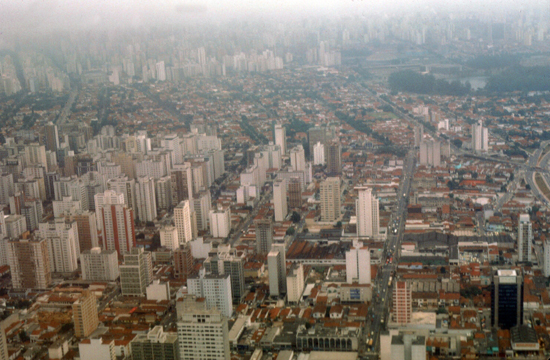 This first shot was taken as we were coming in for our stop at Sao Paulo, and shows the landscape of the city. |
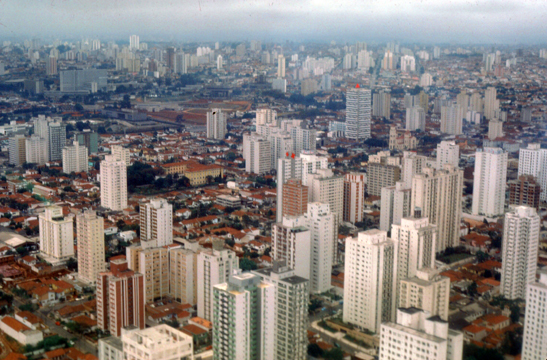 Almost all of what you see in both these pictures is the residential area of the city; I could see the commercial center some distance away, but there was too much smog for a good picture. |
Even though there are mountains near Sao Paulo, there are relatively few in the city itself and, because of that, Sao Paulo looks much different from Rio. Rio has a beauty that is enhanced by the contrast of the mountains and the ocean, like San Francisco, while Sao Paulo is simply a big, sprawling commercial and industrial center, like Chicago (even though Chicago has the lake for natural beauty). At the time I landed, SŃo Paulo had some of the problems of any city its size- congestion and smog. I did not get to see the city more than this, though, since the plane just made a stop here before continuing on. I do recall that the airport was relatively close to the city, and there was some excitement as the plane landed because it comes so close to some of the tall buildings near the airport. Hong Kong is the same way. After a short stop, we flew on to Foz do Iguašu.
Arriving in Foz do Iguašu and Iguašu Falls
|
The Iguašu Falls are located on the border of Argentina and Brazil and were chosen as one of the "New Natural Seven Wonders of the World." The city itself is a tourist town, but, like many other Brazilian cities, is culturally diverse- with large populations from Italy, Portugal, Lebanon, China, Paraguay and Argentina. Foz do Iguašu is integrated into a tri-national region, bordering the Argentine city of Puerto Iguaz˙ and the Paraguayan city of Ciudad del Este.
Steve told me that the town was Brazil's second most visited leisure destination by foreign tourists after Rio de Janeiro. There is a dam being constructed here on the Iguacu River- the Itaipu Dam- which will be downstream from the falls and north of the town on the border between Brazil and Paraguay. It is planned to be the world's largest hydroelectric plant in power generation.
As it turned out, the plane came in directly from the east, and so there was little to see when we landed. I found out later that we were flying over a national park on the way into our landing. Had we come in over Foz do Iguašu, I probably would have taken some. At the airport, Steve had given me instructions on how to head south towards the falls and to my hotel near them on the Brazilian side- the Belmond Hotel.
|
|
Here is what the 2017 website for the hotel has to say: "Enjoy exclusive access to this magnificent sight (the Iguašu Falls) in the evening and at dawn, when the park is closed to other visitors. A Portuguese-colonial residence, this is one of the most inspiring hotels in Brazil. The classic ambiance is redolent of lazy days lounging on a veranda or beneath sub-tropical palms. This natural paradise also offers thrills and excitement in abundance: helicopter trips over the gorge and jungle treks to view amazing wildlife including colourful toucans and giant butterflies."
The hotel was quite right- it was perfectly situated for someone who had come to see Iguašu Falls- I could literally walk out the front door of the hotel, across the lawn or down the short drive and right into the National Park (admission to which came gratis with my stay at the hotel). My picture of the hotel can't really show you its proximity to the falls, but an aerial view borrowed from the hotel's current website can:
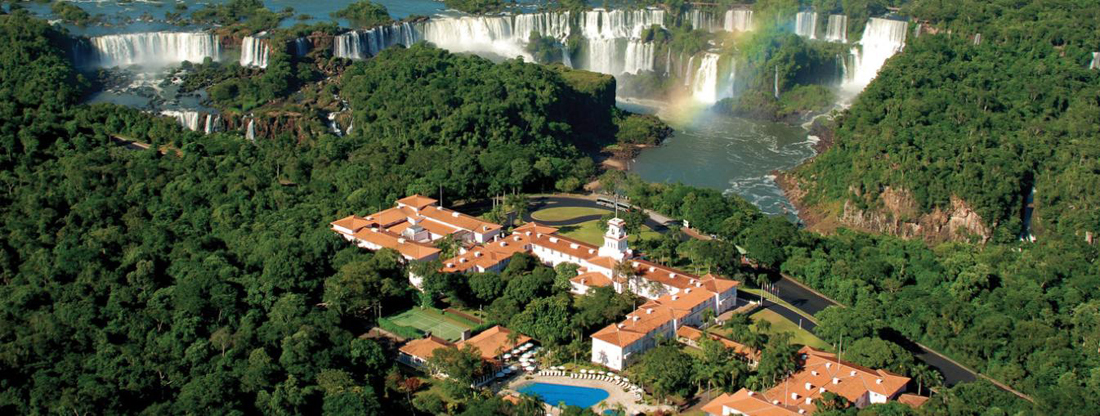 |
I will say, looking at the current picture, is that the hotel was not nearly so large as it is today. I am pretty sure that only the central, U-shaped building was there; I am not even sure that I remember seeing a swimming pool. But then the hotel has had plenty of time to expand in the 35 years since then.
I did not get to see much of the falls this afternoon. Not only had I arrived late in the day, but the weather was threatening and rainy this afternoon. I did go out for my first walk out to the falls, and I did follow some of the boardwalks, but picture-taking was not good, as the light was fading (it was winter, after all), and the sky was full of dark clouds. I did get one picture of a new resort on the Paraguayan side of the river. I learned later that it was part of the Sheraton Hotel chain. This picture looks across the lowest part of the falls, but you can't really see them in the darkness. I hope that my pictures will be better tomorrow.
Iguašu Falls
|
The name "Iguašu" comes from the Guarani or Tupi words "y", meaning "water", and "űas˙", meaning "big". Legend has it that a deity planned to marry a beautiful woman named NaipÝ, who fled with her mortal lover Tarobß in a canoe. In a rage, the deity sliced the river, creating the waterfalls and condemning the lovers to an eternal fall.
The first European to record the existence of the falls was the Spanish conquistador ┴lvar N˙˝ez Cabeza de Vaca in 1541.
I didn't really get to see the falls much yesterday, as it was late in the afternoon when I arrived at the hotel, but today I plan to spend all of my time wandering around the falls. The hotel, constructed in the style of the early Brazilian frontier, is immediately adjacent to the starting point for the trails from the Brazilian side out onto the falls. As you can see, the day was very cloudy. In fact, later in the day, it rained for a while.
In this part of Brazil, the Summer is short and not very hot, but even though it was July, it is not summer here, but rather winter (since I am south of the equator and the seasons are reversed. I arrived on a day that was particularly cold for this time of year. I understand that it never gets very warm up here in the mountains of Brazil.
|
The Iguašu Falls are located where the Iguašu River tumbles over the edge of the Paranß Plateau, 14 miles upriver from the Iguašu's confluence with the Paranß River. Numerous islands along the 1.7 mile edge divide the falls into many separate waterfalls and cataracts, varying between 200 and 270 feet high. The number of these smaller waterfalls fluctuates from 150 to 300, depending on the water level. Approximately half of the river's flow falls into a long and narrow chasm called the Devil's Throat. This chasm is U-shaped, 270 feet high, 500 feet wide and a half-mile long around the shape. Individual names have been given to many of the other, individual, smaller falls, such as San MartÝn Falls, Bossetti Falls, and many others.
I spent most of the day simply walking along the trails and boardwalks, trying to see as much of the entire area as I could. Along the way, of course, I took quite a few pictures, and you can have a look at most of them below:
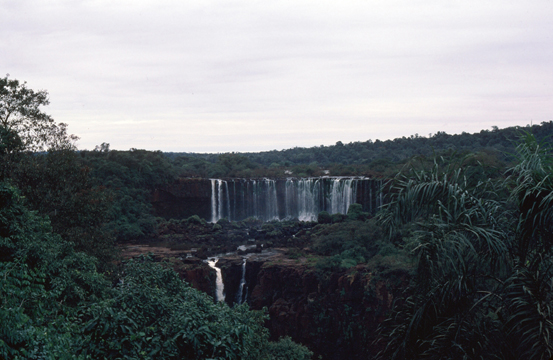 I am a good distance, still, from the falls. To get close to them, you have to walk quite a bit. I certainly didn't mind the walk, both because it was good exercise and because it helped warm me up. I had on only a shirt and sweater; unfortunately, I had not really packed for cold weather. |
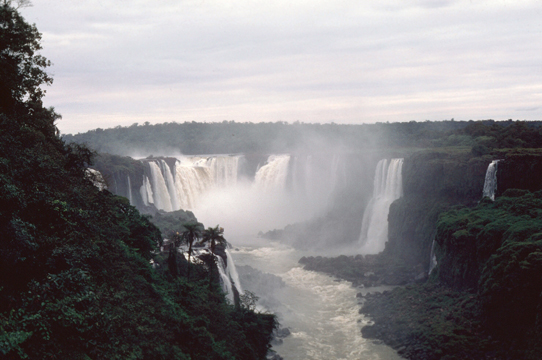 Here is a good view of one of the major falls here at Iguašu. It looks a lot like Niagara, what with the spray and all, but this single fall is smaller than Niagara (although in total Iguašu is much larger). |
About a quarter of the 1.7 mile length of the falls is simply a dry cliff. Erosion has been accurately measured; the edge of the basalt cap recedes by about a tenth of an inch per year. The water of the lower Iguašu collects in a canyon that drains into the Paranß River, a short distance downstream from the Itaipu Dam. The junction of the water flows marks the border between Brazil, Argentina, and Paraguay.
|
In the foreground, you can see some of the wooden walkway. This walkway system runs throughout the Iguašu area; but there are two entirely separate walkway systems. Because the area is on the border between two countries, it is not possible to step between the Brazilian walkway and the Argentinean one. I don't know how the countries patrol their borders at this point; I assume it would be difficult to traverse the rivers and the falls anyway. Furthermore, I'm not at all sure that these particular borders need to be heavily patrolled. I would guess that the relationships between some of these South American countries is much like our relationship with Canada.
While it is necessary at the main border crossings to go through customs, it is possible, without too much effort, to cross the border without doing so, just by walking. Even so, the customs checking at the main crossings is more perfunctory that anything; there is simply too much commerce crossing the border to make detailed examinations possible. I recall that going through customs when I went to England did take a few minutes, but there was no wholesale searching of baggage. I would expect, although I have no knowledge, that Customs on the continent of Europe must be even less demanding, particularly in the small countries around Eastern France and Western Germany. Maybe one day I'll find out.
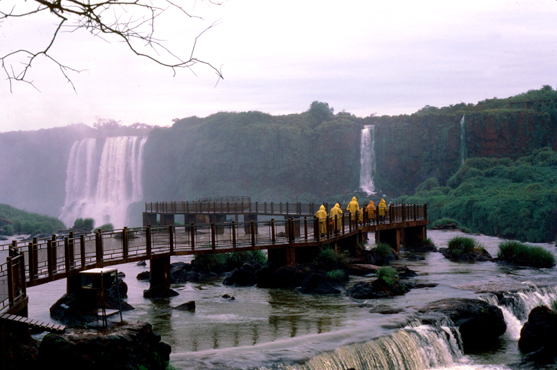 Here you can see how the walkways are laid out. This particular spur goes right out to the base of the falls. At Iguašu, there is a lot more debris at the base of the falls, probably because the water flow is not so violent as to sweep all of it downstream (as happens at Niagara). |
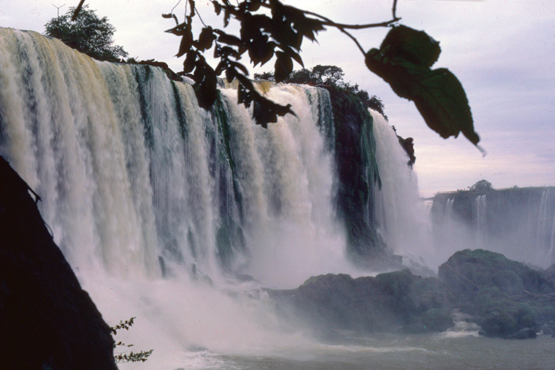 Here, I am very close to the base of one of the major falls. Even though the day was overcast, the falls were still remarkably beautiful. |
At a point near where the walkway took you out to the base of the falls, there was what amounted to a little free-standing closet that was filled with raincoats and rainhats that visitors could borrow so as to stay dry. I don't suppose they have any problem with people keeping them as souvenirs; they are very utilitarian- heavy and not very stylish. (The Hotel also has them for use, but I didn't know that.)
|
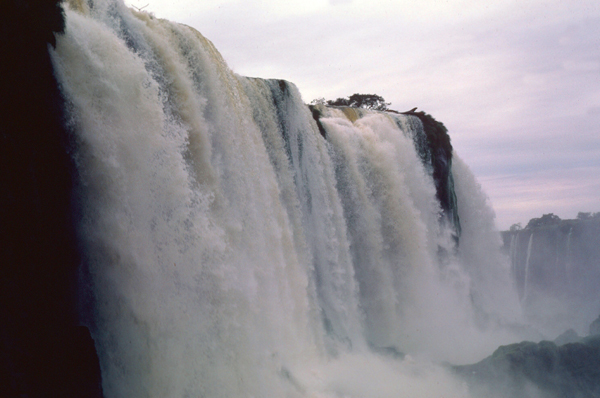 |
Walking around here on the wet walkways reminded me a great deal of Niagara, where there are some similar walkways, and where you can also take The Maid of the Mist to sail to the base of the falls themselves. Here, though, the walkways were mostly up high rather than down by the base of the falls.
|
|
As you can see, I still have my beard, although it is still its light brown summer color. I had never had a beard (or even thought about one) until Tony and I traveled across the country a year or so ago to visit Greg; we were gone almost two weeks, and I didn't shave in all that time. When I returned, I had so many compliments on how it made me look older and more distinguished that I have left it on ever since. Perhaps it will become permanent.
You can see in many of these pictures that there is a great deal of rocky debris at the base of all the falls. The plateau is level again once the water drops over the escarpment, and so there is not enough force to carry this debris much further downstream. This makes the water take all kinds of different channels after it courses over the falls, and it is not until a mile or downstream that the various rivulets coalesce once again into a single, well bounded watercourse.
Here are two views of the same section of Iguašu Falls. I took the first (leftmost) from the beginning of one of the sections of walkway, and then walked a quarter mile closer to the falls to take the second picture:
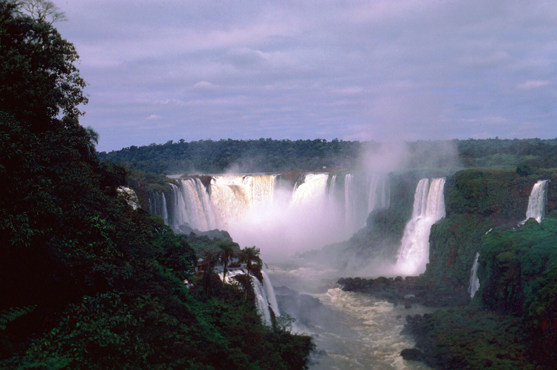 |
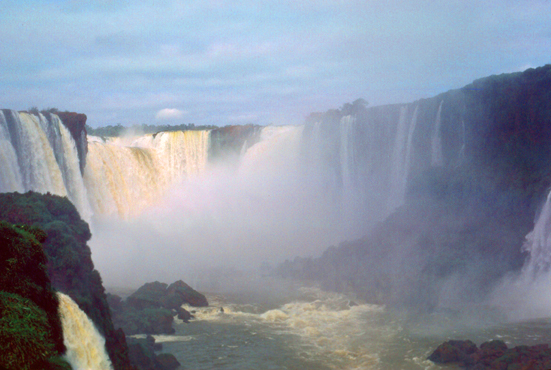 |
I thought that walking around these falls was just incredible, and I thanked Steve profusely when I got back to Chicago for thinking of recommending the side trip for me. Here are the last two pictures I took of the falls in the middle of the afternoon:
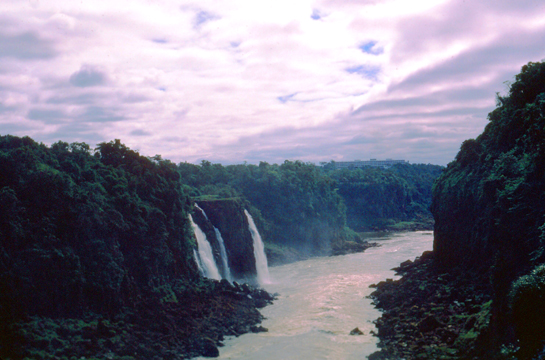 This looks downstream, and you can see how the various channels into which the Parana splits as it moves through the Iguašu complex of falls begin to rejoin into the major river that is the Parana. |
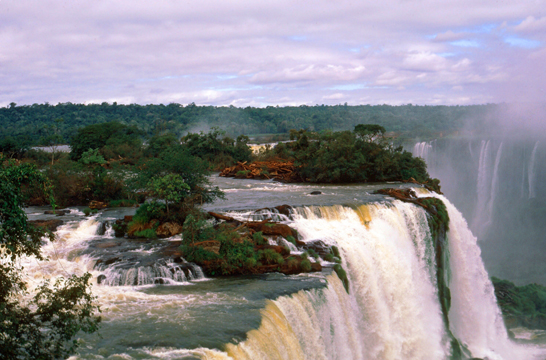 On its way back to the parking area, the walkway climbs up the side of one of the major falls, offering this spectacular shot of the water as it cascades over the rim of the falls. |
All in all, I thought that my trip to Iguašu Falls was very enjoyable. Although I was only there for a day, I could have stayed two or three. There were many small villages in the countryside that it might have been fun to visit, and there are more falls upstream (though not as extensive). But I had to get back to Rio for the main purpose of my trip to South America- teaching a public version of our analysis class. I did get a couple of good views from the plane as I left Foz do Iguašu:
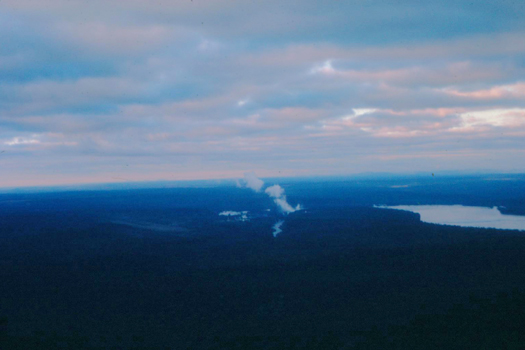 This was taken as the plane left Iguašu for Rio. It is very late in the day, but you can see the area where the Falls are. |
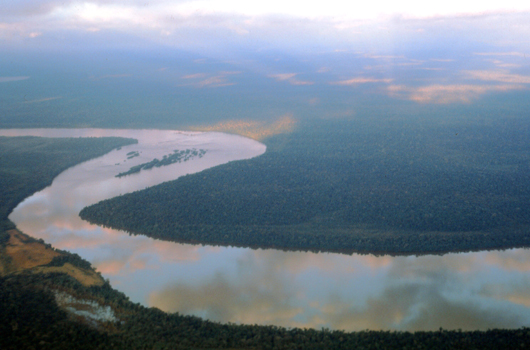 This is the Parana River, upstream from the Falls themselves. |
I got back to Rio about nine o'clock in the evening, got to the hotel and walked out for some dinner. I spent the next day walking along the shore and the beaches and got prepared to start my class the next day.
You can use the links below to continue to another photo album page.
 |
July 7-12: Sightseeing in Rio |
 |
June 1: A Tour of Brasilia |
 |
Return to the Brazil Trip Index |